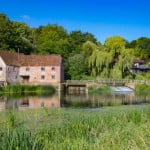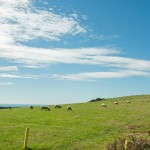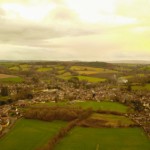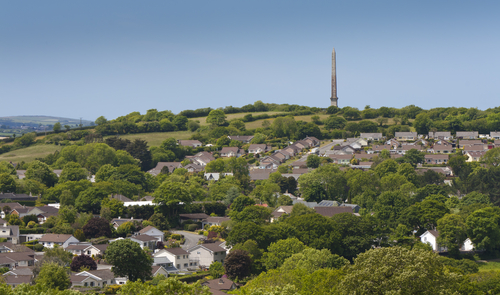
Bodmin is a civil parish and historic town in Cornwall, southwest England. It’s situated inland, 10 miles (16 km) southeast of Padstow, 12 miles ( 19 km) north of Fowey and 3 miles (5 km) southwest of the edge of Bodmin Moor. It is thought that the town’s name is derived from Old Cornish, where ’bod’ means ‘’dwelling’’ (or abode) and with ‘min’, a contraction of ‘menegh’, translating as ‘’monk’’. Bodmin was once the county town of Cornwall and is historically renowned for its notorious jail. At the 2011 National Census, Bodmin had a recorded population of 14,736.
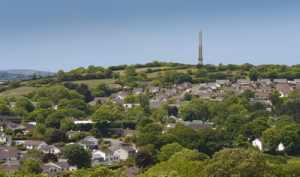
Image: Lee Morriss/Shutterstock.com
A Fleeting History Of Bodmin
The first known settlers in Bodmin were Iron Age Celts who built a hill fort in the town, now known as Canyke Castle. Some believe that the fort is a good candidate for ‘Killiwic’, the fabled 5th century Court of King Arthur. Around 55 AD, the Romans built a fort at Nanstallon, about 2 miles west of Bodmin, to defend a strategic ford crossing of the River Camel. However, Bodmin itself has ancient roots as a meeting place due to the fact that it lies directly on the Saint’s Way. The ancient trading route was frequented by merchants from Ireland, Wales and France, travelling between the north and south coasts of Cornwall.
In 520 AD the locally influential St Petroc arrived in Cornwall from Ireland. He established himself at nearby Padstow and organised the building of a monastery there. However, in accordance with the religious practice of the time, he made it his business to travel around the area. In Bodmin, he found an existing monastic settlement established by the hermit Uuren, who would later become known as St Guron. Over time, the monastery developed and acquired extensive land holdings in the area. By the 9th century, Bodmin is thought to have been known as Dinurrin and been the seat of the Cornish Bishop Kenstec.
In 981 AD the Anglo-Saxon Chronicles record that Padstow encountered a number of raids by the Vikings. It is thought as a result of these attacks, the monks from the Padstow monastery decided to move inland to Bodmin, taking with them the relics of St Petroc. The establishment of the shrine of St Pedroc helped launch Bodmin to become Cornwall’s most important religious centre. By the time of the ‘Great Survey’ in 1086, the Domesday Book recorded that Bodmin with 68 dwellings was the largest settlement and only market town in the whole of Cornwall.
During the 12th century, the Bodmin monastery was taken over by Augustinian monks but continued to dominate the town. During the 13th century, Bodmin began to thrive as a market town with wool and tin being particularly important. Accordingly, in 1285, during the reign of Edward I, Bodmin was granted the status of a borough. However, in 1349, things took a turn for the worse. As with many parts of England, the Black Death struck the town, killing an estimated 1,500 of the pre-epidemic population of 4,000.
Between 1469-1472, the Norman church of St Petroc was largely rebuilt, standing today as the largest parish church in Cornwall. By this period, the mainstay of Bodmin’s economy, like much of the rest of Cornwall, was tin mining. Such was the economic importance of tin mining to the country, Cornwall had been granted a degree of autonomy and the right to oversee the industry through the Stannary Parliament and Laws. However, in 1496, Henry VII decided to suspend these privileges and issued new tin mining regulations. It was an attempt to undermine Cornish self-rule and further the cause of centralisation as well as raise extra money through taxation.
The latter being desperately needed to finance the costly ongoing war with the Scots. The newly imposed higher taxes and the loss of quasi-autonomy status were the final straw for the Cornish. In the summer of 1497, an army of some 15,000 insurgents assembled in the Southwest and marched towards London in what became known as the Cornish Tax Rebellion. The rebels almost reached London but were easily crushed by the King’s forces. At least 1,000 of the protesters were killed but the number of casualties of the King’s army was never disclosed and still not known to this day.
In September 1497, Perkin Warbeck arrived in Cornwall hoping to capitalise on the resentment caused in the aftermath of the uprising only three months earlier. Warbeck, claiming to be the Duke of York and the rightful heir to the throne, declared he would put a stop to the extortionate taxes levied on Cornwall. He was declared “Richard IV” at Bodmin Moor and he and his 6,000 strong Cornish Army soon captured Exeter and began their advance towards Taunton. However, on 4th October 1497, the rebel forces were easily defeated just outside Taunton by the King’s Army. Warbeck was captured and quickly confessed to being ‘a pretender’, and while initially being shown leniency by the monarch, he went on to be hanged at Tyburn in London in 1499.
In 1538, Bodmin Priory fell victim to Henry VIIIs Dissolution of the Monastries, while there’s no trace of the building the old fishpond survives today and is known as Priory Pond. While the monarchy of England was now Protestant, the poor of Cornwall, largely remained staunchly Catholic. Thus, in 1549, when Edward VI tried to impose a new protestant prayer book across the country, the Cornish once again raised an army in protest, gathering at Bodmin. They marched into neighbouring Devon attempting to lay siege to Exeter. A total of 4,000 people were killed during the revolt, with the event becoming known as the Prayer Book Rebellion.
In 1779, the building of Bodmin Goal began, with the construction work being carried out by Prisoners of War. Though the prison wasn’t fully completed until 1788, the first hanging took place there in 1785. After debt ceased to be punishable by imprisonment in 1869, spare capacity at the jail was utilised by the Admiralty. More than 50 public hanging took place during the lifetime of the prison, with the last hanging being in 1909. In 1922, the Royal Navy discontinued their tenure of Bodmin Goal, with the prison finally closing in 1927.
Nineteenth-Century Bodmin
In 1801, the time of the first National Census saw Bodmin with a recorded population of less than 2,000. However, by 1851, the busy market town’s population had grown to over 4,300. But, towards the end of the 19th century, Bodmin once again began to lose local importance and recognition. This was in no small part due to the commencement of work on the construction of the nearby Truro cathedral.
Like many towns across Britain, the relatively prosperous 19th century saw a spate of buildings work in Bodmin. In 1820, St Lawrence’s Hospital was built, although originally as a lunatic asylum. In 1834, a railway line opened between Bodmin and Wadebridge, though not extended the 3 miles to the current station at Bodmin Parkway until 1887. The Shire Hall was built in 1837, Bodmin Market House in 1839, and Bodmin Workhouse in 1842. The Public Rooms were built in 1891, Bodmin Library in 1897, and East Cornwall Hospital was built in 1910.
During World War I, Bodmin Prison was utilised as a secure home for some of the UK’s national treasures, including the Domesday Book and the Crown Jewels.
Prior to the D-Day Landings of 1944, the Barracks of the Duke of Cornwall’s Light Infantry (DCLI) was extended, largely with a view to accommodating American troops arriving in readiness for the massive military operation. The new barracks were named the ‘Walker Lines’ after Lieutenant General Sir Harold Bridgwood Walker, KCB, KCMG, DSO (1862 – 1934) who led the Australian and New Zealand forces for much of World War I. He had begun his army career in Bodmin as a Lieutenant in the DCLI in 1884.
In 1951, the Joint Services School for Linguists (JSSL) was founded at the Walker Lines by the military, to provide language training which was principally Russian. It was also used to house new conscripts about to embark on National Service. The school closed in 1960 when conscription ended, but the site, now an industrial estate is still known as the ‘Walker Lines’.
The Modern Era
Bodmin expanded rapidly during the late 1960s/early 1970s with a great number of council houses being built as a part of the Greater London Council’s overspill scheme. In the mid-1970s the construction of the A30 bypass promoted further development of the town, when light industry began to grow steadily on the southern outskirts adjacent to the new road.
Today Bodmin today is a regional service centre, providing a full range of social and community facilities in health, shopping, leisure, recreation and public transport. With its many attractions, (See below) tourism is now a major part of the local economy.
Getting there!
By Road
If you are driving down to Bodmin, then the best way for the majority will be to take the M4 to Bristol then head south on the M5 to Exeter. Next, turn off for the A30 to Cornwall, turning then turn off for the A38 at Bodmin.
By Bus
There are numerous connections to/from London, Birmingham, Bristol and many other places nationwide to Cornwall available with National Express who make stops at Bodmin Parkway.
By Rail
The town’s railway station is Bodmin Parkway where the trains are operated by First Great Western Railways. Trains running all year round, 7 days a week from London, Bristol, Birmingham, and many other destinations.
By Air
Bodmin is only a 15 miles drive away from Newquay Airport. There are currently 9 airlines that fly to/from Newquay Airport making it an easy way to get to your destination. There are regular flights to and from London. The next nearest airport is Exeter which is about 70 miles and about 75 mins away by road.
Getting around!
Western Greyhound buses operate a large network of local bus services in and around Bodmin as well as the surrounding areas.
Bodmin Sporting Teams
Bodmin Town FC
Bodmin Town is a non-league football club playing in the South West Peninsula Premier League West. Nicknamed the Blacks & Ambers, they were founded in 1889. Their home ground is at Priory Park which was has a capacity of 5,000 (400 seated).
Bodmin RFC
Bodmin Rugby Club is an amateur rugby union team who play in the Cornwall One, Southwest Division.
Notable people
Some notable people who were born or have lived in Bodmin are:
- John Arnold (1736–1799) – renowned London watchmaker, who designed the first practical and accurate watch, was born in Bodmin.
- James Henry Finn (1893 – 1917) – a famed soldier of WWI, who was awarded the Victoria Cross, moved to Bodmin as a child.
- Thomas Flamank – lawyer, local MP and co-leader of the Cornish Rebellion of 1497 (see above) was born in Bodmin. He was hung, drawn and quartered at Tyburn, London in 1497.
- William Hamley – the founder of the oldest and most famous toyshop in the world, ‘Hanleys’, was born in Bodmin in 1741.
- H C McNeil (1888 – 1937) – one of Britain’s most popular inter-war authors, who famously created the Bulldog Drummond character, was born in Bodmin.
Bodmin is twinned with Bederkesa, Germany; Grass Valley, California, USA and Le Relecq-Kerhuon, Brittany, France.
The Beast of Bodmin
Bodmin Moor is renowned for its desolate and rugged landscape, which has spawned a host of associated myths, legends and superstition. None are more famed than that of the ‘Beast of Bodmin’, a fiend which now has a place well and truly secured in Cornish folklore.
The tale of the beast initially came about in 1978 after a supposed incident centred around the closure of the Chipperfield Zoo in Plymouth. At that time, it was claimed that animal trainer Mary Chipperfield had accidentally, or otherwise, released three panthers into the wild. There were soon the inevitable claims of the sightings of the animals, which eventually gave rise to the legend of ‘the Beast of Bodmin’. The fabled creature is most often described as being a black panther-like cat, between 3 – 5 feet long, with white-yellow eyes. In addition to the sightings, the testimony of the beast’s presence on Bodmin Moor has been the numerous reports of mutilated livestock in the area.
In 1995, with evidence and public pressure mounting, the government felt obliged to carry out an official investigation into the possible existence of the beast. The report’s ultimate findings were that; “No verifiable evidence for the presence of a ‘big cat’ was found’’. However, fate would play a hand in the controversy, when a week after the report was published, a boy found a big cat skull lying on the banks of the River Fowey. The speculation and conjecture following the discovery catapulted the story of the ‘beast’ to the front pages of the national press. Was it one of the Chipperfield panthers? Was it a new animal that had escaped from a nearby zoo? Could there be more than one big cat? The Natural History Museum carried out a post-mortem on the skull with their findings revealing that it had been imported into the country as part of a leopard skin rug.
Following the solving of the skull mystery, the hullabaloo surrounding the beast did quieten down to some extent for a little while. However, that was only until 1998, when released video footage clearly showed a black cat-like animal more than a metre in length wandering on the moor. The video was described by the Curator of Newquay Zoo and a wild cat expert, as the best evidence yet that there are big cats roaming Bodmin Moor.
The principal theory surrounding the beast still suggests it is an escaped big cat from a private zoo or collection, which wasn’t reported because it had been imported illegally. Others believed the animal to be a species of large wild cat thought to have been extinct in Britain for more than a century. Yet, others think that there is more than one big cat, which may be the are offspring of the Chipperfield panthers. However, experts reject the latter premise on the basis that the numbers needed to sustain a breeding population are too large for the available food supply. The more extreme theories suggest that the mystical beast could even be a supernatural creation.
Whatever the truth might be, sightings of the Beast of Bodmin continue to this day!
Things to see and do!
A selection of the things to see and do in and around Bodmin include:
- Bodmin Jail – steeped in social history and Georgian architecture, the old goal offers visitors a unique insight into Cornish penal life over the centuries.
- Bodmin Keep – a Victorian Grade II listed building is Cornwall’s Military Museum. Displays cover 300 years of Cornish military life. Holds special events and family activities all year round.
- Camel Trail – linking Padstow, Wadebridge and Bodmin, it follows old railway tracks along the river Camel. Great for cycling, walking and nature trails.
- Bodmin Moor – is situated only a few miles from Bodmin along the A30. With mixed woodland areas, the ‘Moor’ is one of Cornwall’s most important Areas of Outstanding Natural Beauty. A ‘mecca’ for walkers and mountain bikers, there are also kid’s play areas and picnic areas.
- Colliford Lake – is a large freshwater lake situated just of the A30 in the middle of Bodmin Moor. A great venue for fishermen and ramblers alike.
- Camel Valley Vineyard – located at Nanstallon close to Bodmin, produces red, white and sparkling wines. Guide tours and tastings sessions available: Mon – Fri; Spring through to Autumn
- Lanhydrock House – a resplendent late Victorian country house with extensive gardens and a wooded estate is run by the National Trust is located 3 miles from Bodmin.
- Pencarrow House and Gardens – privately owned historic Georgian mansion with large formal gardens, is set in 50 acres of parkland, lake and woodland, located 5 miles from Bodmin.
- The Bodmin Way – is an 18-mile circular route around Bodmin that takes in five historic churches on a local pilgrimage of History, Heritage and the Arts.
- Bodmin and Wenford Railway – is Cornwall’s only full-size railway still operated by steam locomotives. Bodmin General is a 10-minute walk from the town centre from where you can board for the 6-mile journey.
- Bodmin Beacon Local Nature Reserve – is set on a hill that overlooks the town which reaches 162 m at the summit. The reserve is 83 acres of meadow and woodland. Central to the park is a 44m high monument to Lt-Gen. Sir Walter Raleigh Gilbert, which was built in 1857.
Where to stay?
There’s a limited amount of accommodation in and around Bodmin but you will find prices a little further afield are similar. A rough guide to prices per night for 2 adults sharing is:
B&B/Guesthouse/Inn: £70 – 100
Hotel: £100 – 160

